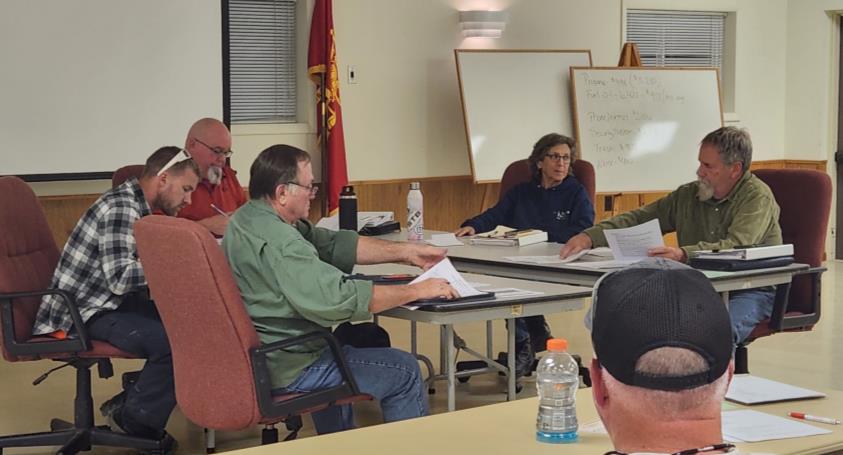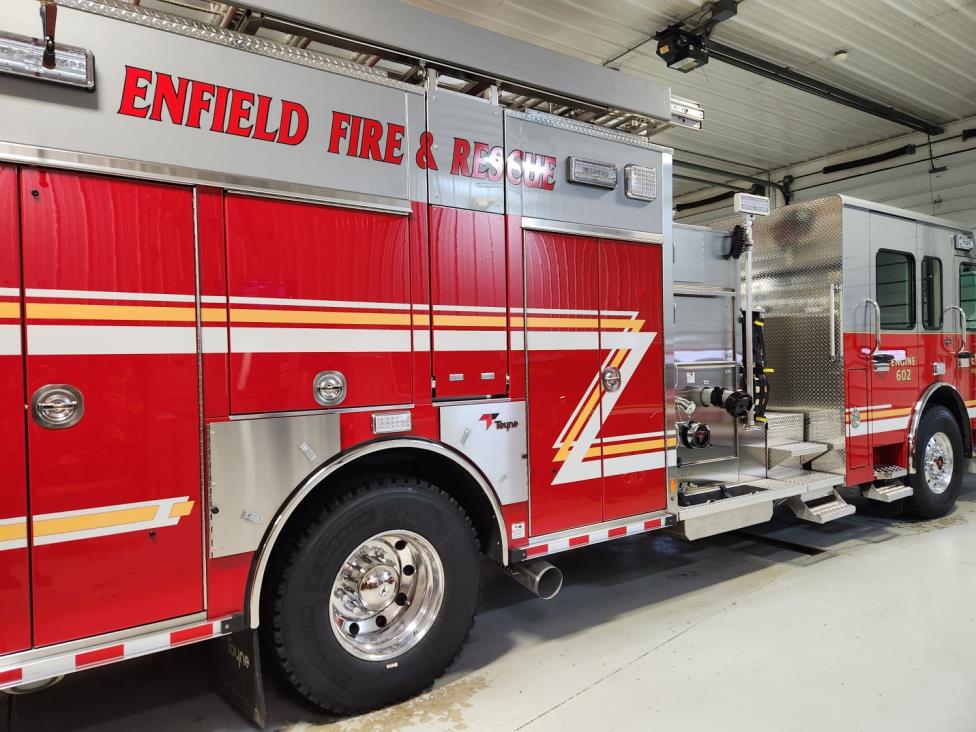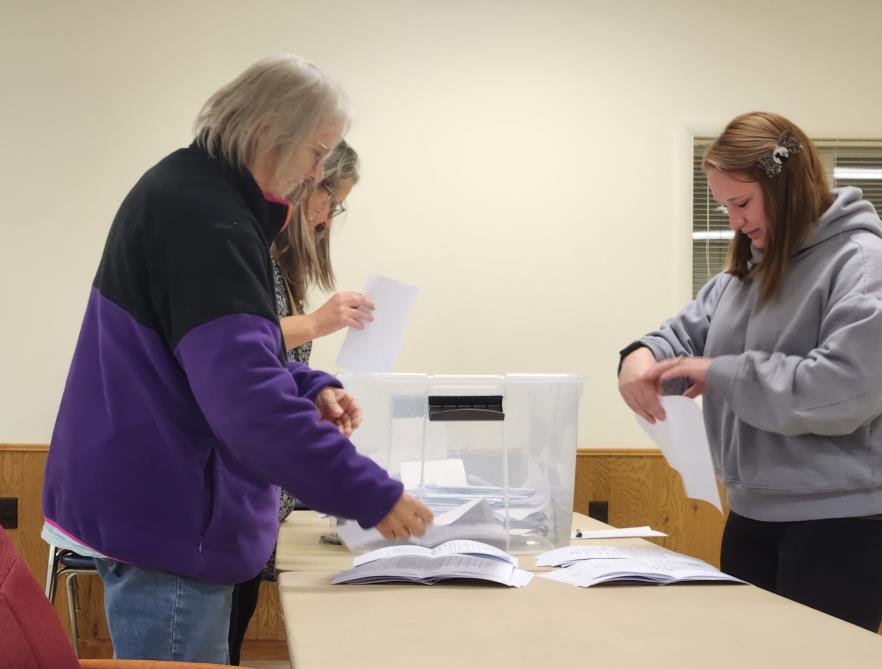Big truck’s financing blamed; other costs up just slightly
by Robert Lynch; September 12, 2024
For the second straight year, Enfield taxpayers may face a double-digit hike in their Fire Tax. And if they’re looking for the reason, they’ll find it the same. It’s that spanking-new, shiny red fire truck; the one Enfield fire officials have always insisted they need, but which a vocal minority of residents grumble about paying for.

Initial figures, detailed in a Quarterly Report presented the Enfield Town Board Wednesday night, indicate that the proposed 2025 Enfield Fire District Budget may total $627,148, a 29.67 per cent increase from the 2024 Budget Enfield’s Board of Fire Commissioners approved one year ago.
The tentative 2025 total is based on a calculation made by Fire Commissioner Chris Willis and stated publicly at the close of the Commissioners’ most recent budget planning session September third. The Board of Fire Commissioners intends to finalize its budget September 17th.
Nickel and dime expenses do not account for the latest projected double-digit increase. Fire truck bonding outlays do. When the financing costs of the 2023 Toyne pumper engine are subtracted, the proposed Fire Budget shrinks to $550,571, a mere 3.49 per cent increase over 2024, based on Willis’ numbers.
“I don’t believe that total is 100% accurate, seeing as we have a few line items in our budget that may vary depending on some research and finalization for the 2025 year,” an Enfield Fire District official said Wednesday after being presented the Quarterly Report prior to the Town Board meeting, “so it may be worth it to mention that the $550k is not a finalized number.”
But the pumper’s $126,576 financing expense is, essentially, locked-in.
The 2025 budget line covers $86,696 in principal and $39,880 in interest due on bonds the Board of Commissioners authorized back in March.
The truck was bought last year by the Enfield Volunteer Fire Company (EVFC), which then held purchasing authority. It was gifted to the Enfield Fire District last March as part of Enfield’s transition to a fire district form of governance. Along with that transfer, the Board of Fire Commissioners sold the truck’s ten-year serial bonds to a bank around April first.
“I stressed in my report that the budget figure is preliminary,” this writer, Councilperson Robert Lynch, liaison to the Enfield Fire District and author of the Quarterly Report, responded to the concerned District official. “While a few figures may change here or there, the basic total is not likely to change much,” I maintained.

“We’re looking at about the same as last year with bond payments on top of that,” Board of Fire Commissioners Chair Greg Stevenson observed of the proposed budget during the September third meeting.
Indeed, in a series of three budget planning sessions that began with a non-voting “workshop” August 12th, Commissioners made no radical departures from 2024 spending aside from adding-in the pumper’s first-year bonding expense. The closest they came to a dramatic change was to increase—without much explanation—the projected annual salary for the Fire District Secretary.
Under the current budget draft, the Secretary’s salary would rise from $2,000 to $5,000. The District’s other compensated appointee, the Treasurer, would see her salary remain flat at an equal $5,000.
If current estimates hold, 2025 would mark the second time in as many years that Enfield fire budgets have carried sticker shock.
Last year, a newly-appointed Board of Fire Commissioners, still finding its sea legs and leaning heavily on its then-attorney’s guidance, initially proposed a 2024 budget that was only 3.2 per cent higher than the prior year’s spending plan. The Board took that budget to public hearing, but amended its total upwards by nearly $94,000 four days after the hearing. The lawyer said it was legal. But many taxpayers felt stung.
The then-revised and eventually-adopted 2024 budget raised fire service spending by more than 28 per cent above that for 2023. Two of the Town Board-appointed Commissioners on that fledgling Board of Commissioners chose not to seek election last December. A third was defeated at the polls. And by the following January, the attorney had also lost his Enfield job.
Now, a 29 per cent fire spending hike could be in store for Enfield. If the latest plan is enacted, the two budgets, taken together, would have raised local fire protection costs by 66 per cent in just two years.
“Cut a little here; cut a little there,” Chairman Stevenson told Commissioners at the close of their second budget meeting, August 20th. They’ve tried.
When the Volunteer Fire Company contracted for the pumper engine earlier this decade, the law didn’t then require the voters to approve its purchase. Were the truck bought today, the revised procedures affecting fire district governance would demand a referendum. The Enfield attitudinal divide on this truck became evident last October when voters approved its long-term bonding by only an eight vote margin (77 to 69.) The referendum was viewed as a gauge of the fire truck’s guarded support in the community.
Although the appointed Commissioners last year budgeted $65,000 for “loan payments” to cover debt service on not only the pumper, but also on a previously-bought tanker truck with bank financing ongoing, the newly-elected Board changed course earlier this year and modified its predecessor’s plans.
Rather than bond the pumper truck for 20 years, as the October referendum would have allowed, the new Board shortened the bonding term to just ten years. And it chose not to bond the tanker at all, but rather to save money by continuing the tanker’s low-interest bank loan.

The two decisions will save taxpayers in the long-term, but those actions front-load the obligations. And the $65,000 set aside for debt payments last year was gobbled up this year in a couple of ways. Commissioners used some of it to pay the tanker’s loan installments and also to meet pre-bonding transition expenses for the pumper, exigencies for which the former attorney had never provided.
Enfield residents don’t get to vote on a Fire Budget. But the law does mandate a Public Hearing. This year’s hearing must be held October 15th, the month’s third Tuesday.
One year ago, as one of the routines a newly-formed fire district must consider, the Board secured voter approval to override a state-specified statutory limit on its spending. Voters approved a new, higher limit of $575,000. And while the new budget’s calculated total would exceed the limit, officials say the bonding costs and certain lesser items don’t count toward the statutory ceiling. As such, what’s proposed passes the test.
Addressing a second obstacle, Commissioners, at their August 20th meeting, voted to override the state’s otherwise-limiting two per cent capped increase in the tax levy. Stevenson called the override “a bit of a no-brainer.”
During their latest budget session, September third, Fire Commissioners tentatively placed $10,000 of their proposed budget into each of two reserve accounts; the Equipment Repair and Replacement Reserve, and a similar reserve for Apparatus. Once money goes into such reserves, it can’t easily come back out unless used for its intended purpose.
Last year’s Board budgeted $12,638 into the two reserves. Yet it never split the funds between them. Stevenson has proposed the funds now get divided equally.
At the Budget Workshop August 12, Chairman Stevenson—apparently at the attorney’s advice—floated the prospect of asking voters this December to authorize a third reserve account; a “Building Repair and Replacement Reserve.”
“Someday we will have to decide whether to buy the fire station or build a new one,” Stevenson told the Board that night.
But later, feeling the pinch of economy, Commissioners pretty much set the Building Reserve idea on a shelf. Members concluded that the EVFC will likely always make its space available to the District and to its fire trucks. “We don’t need a third place to put money,” Stevenson remarked August 20, referring to the new reserve. He has no plans to bring its creation to a vote this December.
As this Councilperson read the Quarterly Report into the record Wednesday night, other Town Board members remained mum. The Town Board no longer holds any control over the Enfield Volunteer Fire Company or the Fire District that now oversees it. Town Board members may now view fire finances as somebody else’s problem, not theirs.
****
Other business came before the Enfield Town Board Wednesday night:
Town Solar: By a unanimous vote, the Town Board moved ahead with a newly-hatched plan to place solar panels atop the Town Hall, commonly known as the Old Highway Barn, the one housing the Town Clerk’s Office, a Sheriff’s Department substation, and equipment storage.

A newly-secured NYSERDA Clean Energy Communities Grant will underwrite $60,000 of the cost. . One solar company quoted $64,000 for the installation, meaning Town taxpayers may need to pay only about $4,000.
Over time, the solar power would defray Town Government’s electric bills, not only at the Town Hall, but also at other Enfield buildings.
Councilperson Jude Lemke questioned whether rooftop solar was the best use of the NYSERDA money, noting it will take time—many years—to recoup the overall investment. But Supervisor Stephanie Redmond cautioned that Town options remain limited. Redmond had asked whether the state agency would pay to insulate underused parts of the old highway barn to enable its expanded future use. Redmond was told the grant money wouldn’t qualify for an improvement like that.
Tree Cutting: Several Enfield residents again appeared before the Town Board to question Highway Superintendent Barry “Buddy Rollins” about his controversial tree-pruning practices—particularly along Rockwell Road—practices some find too aggressive.

“We would like to keep the character of our road,” Rockwell’s Julie Magura told Rollins and the Board.
“I’m concerned these big, beautiful trees are going to be cut down,” Van Ostrand Road’s Madonna Stallman said about those standing at a place she admires. ”Do we need to be going to the state, particularly in view of climate change?” Stallman asked after Rollins informed her that state law purportedly mandates he clear the right-of-way as he does.
Rollins said he’ll resume trimming the Rockwell foliage—often removing its overhead canopy—“the week after next.” Rollins offered waivers for landowners to sign if they want their trees kept; waivers holding the owners responsible for any debris clean-up. Several expressed interest in signing.
Supervisor Redmond plans another round of tree-pruning discussions October ninth.
Dog Law: The Town Board held off finishing and scheduling for public hearing a revised Dog Control Law that’s been under Board discussion for months. It also delayed approving the SPCA’s requested two-year renewal of its Animal Control Services Agreement.
Board members believe the two measures are tied. And before they approve the SPCA’s renewal, they want to confer directly with agency Director Jim Bouderau, who was unable to attend Wednesday’s meeting. They’d also like the long-dormant, multi-municipality SPCA Advisory Board to reconvene. The Advisory Board is supposed to negotiate terms of the Animal Control Agreement on the municipalities’ behalf. It hasn’t.
Road Safety: And the Town Board adopted a Resolution requesting a New York State and Tompkins County traffic study of the intersection of Route 79 with Black Oak and Waterburg Roads, the scene of several recent accidents. Route 79 is rolling, with driver visibility limited at the crossing. The Resolution asks engineers to” determine whether additional traffic controls, improved signage, and/or reduced speed limits are advisable,” and if so, to “then implement those recommended improvements.”
###

